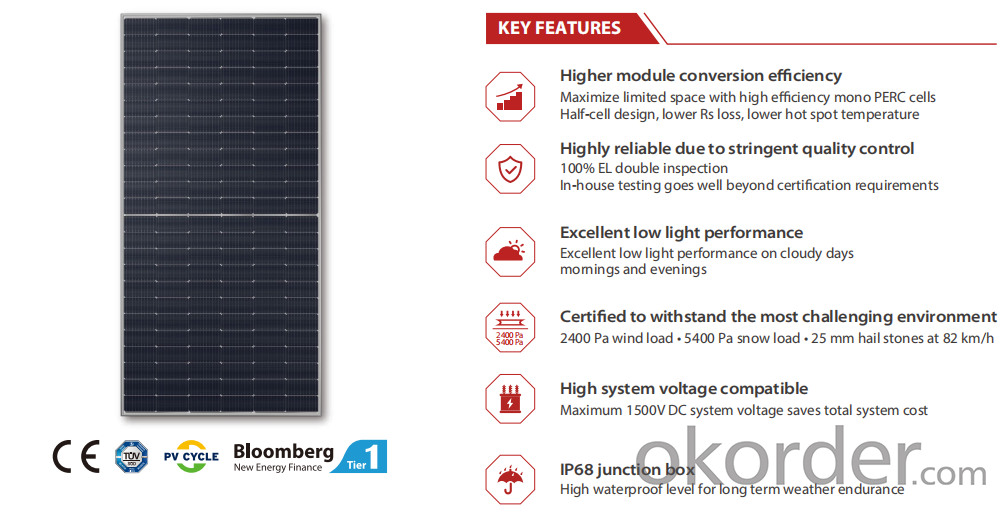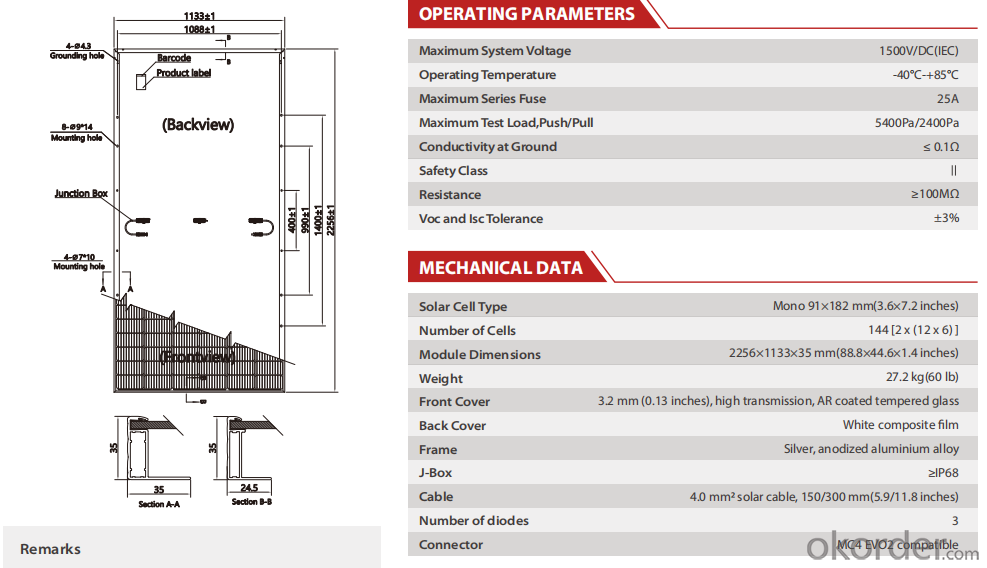jetion Solar mono bifacial solar panel price 540W double glass PV module for solar farm
- Supplier:
 Jetion Holdings Limited
Jetion Holdings Limited
- Loading Port:
- China main port
- Payment Terms:
- TT OR LC
- Min Order Qty:
- 620 pc
- Supply Capability:
- 500000 pc/month
OKorder Service Pledge
Quality Product, Order Online Tracking, Timely Delivery
OKorder Financial Service
Credit Rating, Credit Services, Credit Purchasing
You Might Also Like
Structural characteristics
| Component size | 2279x1134x35mm |
| Weight | 33 kg |
| Battery | Mono 182 mm (2 x78pcs) |
| Glass | Coated, 3.2mm toughened glass, low iron |
| Frame | Anodized aluminium alloy |
| Junction box | IP68 |
| Output wire | 4.0mm², wire length: 1200mm for positive and negative poles |
| Connector | MC4 compatible |
| Mechanical load | Front maximum: 5400Pa;Back maximum: 2400Pa |




- Q:Can solar panels be installed on airports or transportation hubs?
- Yes, solar panels can be installed on airports or transportation hubs. In fact, many airports and transportation hubs around the world have already installed solar panels as part of their sustainability initiatives. These panels help generate clean and renewable energy, reducing their carbon footprint and dependence on traditional energy sources. Additionally, the large open spaces available in these areas make them ideal for solar panel installations.
- Q:Do solar panels require a backup generator?
- No, solar panels do not require a backup generator as they generate electricity directly from sunlight, eliminating the need for external power sources.
- Q:I am seriously thinking about installing PhotoVoltais Solar panels (that generate electricity) on my roof. Besides the usual (cost, ROI, etc.), I was researching for the maintenance of these panels. We have tall trees around the house and needles and leaves fall on our roof all the time... not to mention the dirt and grime that collects over time.Do these decrease the capacity of the panels? Do the panels require a regular maintenance?Thanks!
- New solar panels are clean and shiny and they look cool. Then they get dirty with dust and debris caught on the wind and residues left behind by rain and birds. Solar panels must be regularly cleaned and maintained in order to keep them operating efficiently and maximize the amount of sunlight they convert into electricity. Unlike windows your solar system needs to have a clean and clear surface to ensure they are working at their maximum efficiency. If they are not at their optimum performance it means they are not producing the amount of electricity that they could be. Solar panels will attract dirt, dust, soot, pollen, tree sap and salt crystals in coastal regions creating a fine layer of grime. This layer reduces the amount of light reaching the silicon cells under the glass surface and reduces the panel's effectiveness. A solar panel that has never been cleaned could be producing almost a third less power than it otherwise could be. Some have reported a ten to fifteen percent loss of solar output due to dirty panels. From the ground the panels may appear to be clean, just like your windows. Up close however you can see the grime that has built up from the dirt and pollution in the air. A more noticeable deposit that can be left on panels is bird droppings. These tend to completely block the light from areas of the photovoltaic panel and can considerable reduce its effectiveness. See much more about solar panels maintenance below link
- Q:Can solar panels be installed on any type of roof?
- Solar panels can be installed on most types of roofs, including flat, sloped, and metal roofs. However, the suitability of a roof for solar panel installation depends on factors such as its orientation, shading, structural integrity, and load-bearing capacity. It is recommended to consult with a solar professional to assess the specific requirements and feasibility for installing solar panels on a particular roof type.
- Q:I want to install a solar panel system and our power grid can't work in reverse(so it get its electricity from us). My question is how do you prevent electricity from our panel to go to the grid without disconnecting the grid? How can we also use the grid and the panel at the same time when the panel are not creating enough power?PS dont say ask an electrician
- If you are grid-tied, then a standard solar electric system will always feed back into the grid if you are not utilizing more power in your home than is being generated by the solar panels and inverter system. It is possible that a grid isolation device designed to prevent direct back feeding is available, but haven't heard of one in common use. New laws in most areas of the US are now mandating that utilities allow grid-tied alternative energy systems. Double-check you local laws. Sometimes you can't take the utilities word for truth--most will automatically say 'no' and will only relent when you show up with the law in hand. Unfortunately, some utilities have figured out another way to shut down alternative energy pioneers--they demand multimillion dollar insurance policies covering damage that their equipment could sustain from your little PV system. Technically, they are still in compliance with the law, they just make it impossible for a homeowner to meet their requirements. If you are getting the runaround, go to your state representative for help. It's amazing how contrite those utility people can be when a state senator (or even US Senator) has just sent a letter asking them why they are stonewalling a law-abiding and well-meaning citizen. Good luck, and don't give up!
- Q:I need to know how solar photovoltaic panels work. Anyone have a good explanation?
- Hey E Girl, photovoltiac panels are pretty simple. They start with a solid block of silicone, and shave thin layers off of them, called wafers. Once you have about 72 of them, you take half of them and dope them with boron, then the other half are doped with phosphorous. Once that's done, they take one each phosphorous and boron wafer, and glue them together with a special conductive epoxy glue, and attach a wire to each wafer. When the two glued wafers are exposed to the sun, a reaction occurs that forces free electrons from the silicone particles from one wafer onto the other, and a voltage is generated between them, about /2 volt to be exact. Once all 36 pairs are glued together, they are wired in series, connecting the phosphourous wafer from one to the boron wafer on the next, and so on. If you start with 72 wafers, you'll have 36 pairs glued together when you are done. At /2 volt each, that makes a 8 volt panel, which is used to charge a 2 volt battery. The charging source always has to have a few more volts than the battery. These 36 pairs of cells are then arranged on some kind of back board, glued down, covered with acrylic glass and mounted in a frame. There are some great websites you can go to for more info, I will list some below. Did you know that there are over 00,000 homes and businesses in the US alone that use some level of solar power to operate their electrical systems? That's good news. We actually live in one of those homes, it is powered by both the wind and sun and heated with solar and wood. I hope this answers your question, good luck, and take care, Rudydoo
- Q:How much would it cost to make an average size house be able to depend on solar panels for all of its power?How many solar panels would you need and wear would you put them? Would the roof be large enough to support the panels needed?Do solar panels work well in higher latitudes like northern USA or southern Canada? Can you power your house for the whole year if you live in these environments? What kind of maintenance do solar panels require?
- I can begin to point you in the right direction. It is a very complicated thing you are asking about. Solar panels produce direct current, in order to store that power for use at night, and on cloudy days, you need a lot of batteries. Those batteries store direct current. In order to use that direct current to power your refrigerator, you need to put it through a thing called an inverter. The inverter produces AC from DC. You may have seen one for sale to plug into the lighter in a car so you can use things that require AC in your car. The inverter looses power doing the conversion. Over time, you can purchase direct current appliances, and make the system more efficient. Years ago, a decision was made to go with AC because of transmission issues (you can move AC across a wire a long distance, and DC is more difficult to move). Many appliances convert AC to DC internally to do their work, but such appliances are expensive. Have I answered your question? Not really. You should understand your question better though.
- Q:Can solar panels be installed on a commercial building?
- Yes, solar panels can be installed on a commercial building. In fact, many businesses are opting for solar panel installations as a way to reduce energy costs, promote sustainability, and take advantage of government incentives. Commercial buildings provide ample space for solar panels to be installed on rooftops or as ground-mounted systems, allowing businesses to generate clean energy and contribute to a greener future.
- Q:Photosynthesis is fairly inefficient, but efficient enough to power all life on earth.
- Si is a neutral semiconductor, and, when combined with the other metals in the solar panel, it the panel polarizes, and releases electrons form one end, and accepts them back at the other. Like a water pump. Mg is not the major ingredient because it doesn't have the easily altered semiconductor properties Si does. To put it simply, Si is easier to work with.
- Q:I have created a solar setup in my shed i have 2x.5w solar panels i am hoping to charge my 55ah car battery how long would it take to charge the battery and how many watts could i used a day
- 55ah Car Battery
1. Manufacturer Overview |
|
|---|---|
| Location | |
| Year Established | |
| Annual Output Value | |
| Main Markets | |
| Company Certifications | |
2. Manufacturer Certificates |
|
|---|---|
| a) Certification Name | |
| Range | |
| Reference | |
| Validity Period | |
3. Manufacturer Capability |
|
|---|---|
| a)Trade Capacity | |
| Nearest Port | |
| Export Percentage | |
| No.of Employees in Trade Department | |
| Language Spoken: | |
| b)Factory Information | |
| Factory Size: | |
| No. of Production Lines | |
| Contract Manufacturing | |
| Product Price Range | |
Send your message to us
jetion Solar mono bifacial solar panel price 540W double glass PV module for solar farm
- Supplier:
 Jetion Holdings Limited
Jetion Holdings Limited
- Loading Port:
- China main port
- Payment Terms:
- TT OR LC
- Min Order Qty:
- 620 pc
- Supply Capability:
- 500000 pc/month
OKorder Service Pledge
Quality Product, Order Online Tracking, Timely Delivery
OKorder Financial Service
Credit Rating, Credit Services, Credit Purchasing
Similar products
New products
Hot products
Hot Searches
Related keywords



























